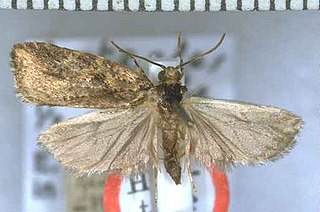
Izatha metadelta is a moth of the family Oecophoridae. It is endemic to New Zealand, where it is known from the North Island only. It is rare north of Waikato and the Bay of Plenty.
Helcystogramma ineruditum is a moth in the family Gelechiidae. It was described by Edward Meyrick in 1926. It is found in Russia.

Pyrgotis eudorana is a species of moth of the family Tortricidae. It is endemic in New Zealand and has been observed in both the North and South Islands. However it is regarded as a rare insect. This species inhabits native forest. Larvae exclusively feed on Muehlenbeckia australis and adults are on the wing from November to April. Adults are attracted to light.
Cryptolechia centroleuca is a moth in the family Depressariidae. It was described by Edward Meyrick in 1922. It is found in India (Sikkim).
Helcystogramma craticula is a moth in the family Gelechiidae. It was described by Edward Meyrick in 1921. It is found in Mozambique.
Dichomeris procyphodes is a moth in the family Gelechiidae. It was described by Edward Meyrick in 1922. It is found in Amazonas, Brazil.
Dichomeris crambaleas is a moth in the family Gelechiidae. It was described by Edward Meyrick in 1913. It is found in Taiwan and Assam, India.
Dichomeris citharista is a moth in the family Gelechiidae. It was described by Edward Meyrick in 1913. It is found in southern India.
Dichomeris festa is a moth in the family Gelechiidae. It was described by Edward Meyrick in 1921. It is found in South Africa.
Helcystogramma adaequata is a moth in the family Gelechiidae. It was described by Edward Meyrick in 1914. It is found in Guyana.
Helcystogramma symbolica is a moth in the family Gelechiidae. It was described by Edward Meyrick in 1914. It is found in Guyana.
Helcystogramma nesidias is a moth in the family Gelechiidae. It was described by Edward Meyrick in 1911. It is found on the Seychelles, where it has been recorded from Mahé, Praslin and Silhouette.
Helcystogramma meconitis is a moth in the family Gelechiidae. It was described by Edward Meyrick in 1913. It is found in Argentina.
Hypatima caryodora is a moth in the family Gelechiidae. It was described by Edward Meyrick in 1913. It is found in Assam, India.
Hypatima corynetis is a species of moth in the family Gelechiidae. It was described by Edward Meyrick in 1913. It is found in Sri Lanka.
Deltoplastis balanitis is a moth in the family Lecithoceridae. It was described by Edward Meyrick in 1910. It is found in southern India.
Epichostis metrodelta is a moth in the family Xyloryctidae. It was described by Edward Meyrick in 1905. It is found in Sri Lanka.
Epichostis elephantias is a moth in the family Xyloryctidae. It was described by Edward Meyrick in 1906. It is found in Sri Lanka.
Aeolanthes siphonias is a moth in the family Depressariidae. It was described by Edward Meyrick in 1908. It is found in northern India.

Proteodes profunda is a species of moth in the family Depressariidae. It is endemic to New Zealand. This species has been collected in its type locality of Mount Holdsworth in the Tararua Range, Raurimu near Tongariru National Park, Days Bay in Wellington, Mount Arthur, Otira, Invercargill, and in Southland. P. profunda lives in beech forests at altitudes of around 2000 ft and larvae feed on beech tree leaves. Adults of this species are on the wing from November to February.


